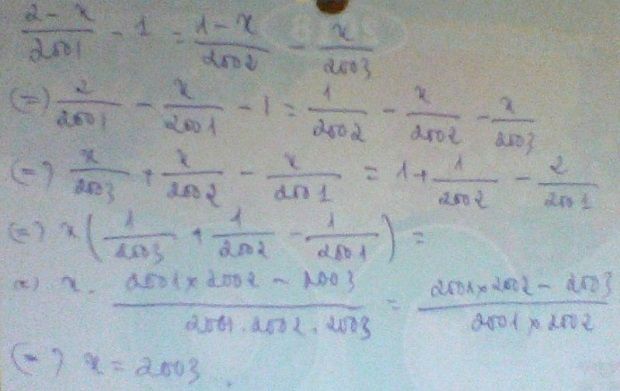
Hãy nhập câu hỏi của bạn vào đây, nếu là tài khoản VIP, bạn sẽ được ưu tiên trả lời.


\(\frac{2-x}{2001}-1=\frac{1-x}{2002}-\frac{x}{2003}\)
\(\Leftrightarrow\frac{2-x}{2001}+1=\frac{1-x}{2002}+1+\left(\frac{x}{2003}-1\right)\)
\(\Leftrightarrow\frac{2-x+2001}{2001}=\frac{1-x+2002}{2002}+\frac{x-2003}{2003}\)
\(\Leftrightarrow\frac{2003-x}{2001}=\frac{2003-x}{2002}+\frac{x-2003}{2003}\)
\(\Leftrightarrow\left(x-2003\right)\left(\frac{1}{2003}+\frac{1}{2001}-\frac{1}{2002}\right)=0\)
\(\Leftrightarrow x-2003=0\)\(\left(v\text{ì}\frac{1}{2003}+\frac{1}{2001}-\frac{1}{2002}\ne0\right)\)
\(\Leftrightarrow x=2003\)
Vậy \(S=\left\{2003\right\}\)
d)Ta có : \(\frac{2-x}{2001}-1=\frac{1-x}{2002}-\frac{x}{2003}\)
\(\Leftrightarrow\frac{2-x}{2001}+1-2=\frac{1-x}{2002}+1+1-\frac{x}{2003}-2\)\(\Leftrightarrow\frac{2003-x}{2001}=\frac{2003-x}{2002}+\frac{2003-x}{2003}\)
\(\Leftrightarrow\frac{2003-x}{2001}-\frac{2003-x}{2002}-\frac{2003-x}{2003}=0\)\(\Leftrightarrow\left(2003-x\right)\left(\frac{1}{2001}-\frac{1}{2002}-\frac{1}{2003}\right)=0\)
\(\Leftrightarrow2003-x=0\Leftrightarrow x=2003\)
Vậy phương trình có tập nghiệm S = { 2003 }


\(\frac{2-x}{2001}-1=\frac{1-x}{2002}-\frac{x}{2003}\)
\(\Leftrightarrow\frac{2-x}{2001}+1=\left(\frac{1-x}{2001}+1\right)+\left(\frac{-x}{2003}+1\right)\)
\(\Leftrightarrow\frac{2003-x}{2001}=\frac{2003-x}{2002}+\frac{2003-x}{2003}\)
\(\Leftrightarrow\left(2003-x\right)\left(\frac{1}{2001}-\frac{1}{2002}-\frac{1}{2003}\right)=0\)
\(\Leftrightarrow\left(2003-x\right)=0\) (vì \(\frac{1}{2001}-\frac{1}{2002}-\frac{1}{2003}\ne0\))
\(\Leftrightarrow x=2003\).
Vậy tập nghiệm của phương trình là \(S=\left\{2003\right\}\).


\(\dfrac{x-4}{2001}\)- 1 +\(\dfrac{x-3}{2002}\)-1 + \(\dfrac{x-2}{2003}\)-1 =\(\dfrac{x-2003}{2}\)-1 + \(\dfrac{x-2002}{3}\)-1 +\(\dfrac{x-2001}{4}\)-1 <=> \(\dfrac{x-2005}{2001}\)+\(\dfrac{x-2005}{2002}\)+\(\dfrac{x-2005}{2003}\)-\(\dfrac{x-2005}{2}\)-\(\dfrac{x-2005}{3}\)-\(\dfrac{x-2005}{4}\)= 0 <=> (x-2005). (\(\dfrac{1}{2001}\)+\(\dfrac{1}{2002}\)+\(\dfrac{1}{2003}\)-\(\dfrac{1}{2}\)-\(\dfrac{1}{3}\)-\(\dfrac{1}{4}\)) =0 <=> x-2005=0 ( vì \(\dfrac{1}{2001}\) +\(\dfrac{1}{2002}\) +\(\dfrac{1}{2003}\)- \(\dfrac{1}{2}\) -\(\dfrac{1}{3}\)- \(\dfrac{1}{4}\) khác 0) =>x = 2005
x-4/2001+ x-3/2002 + x-2/2003= x-2003/2 + x-2002/3 + x-2001/4
<=>(x-4/2001 -1)+(x-3/2002 -1)+(x-2/2003 -1)-(x-2003/2 -1)+
(x-2002/3 -1)+(x-2001/4 -1) =0
<=>x-2005/2001+ x-2005/2002+ x-2005/2003- x-2005/2-
x-2005/3- x-2005/4 =0
<=>(x-2005).(1/2001+1/2002+1/2003- 1/2- 1/3- 1/4)=0
<=>x-2005=0 (vì 1/2001+1/2002+1/2003-1/2-1/3-1/4)
<=>x=2005
Vậy pt có nghiệm là x=2005

a,\(\Leftrightarrow\left(\frac{1-x}{2013}+1\right)=\left(\frac{2-x}{2012}+1\right)-\left(1-\frac{x}{2014}\right)\)
\(\Leftrightarrow\frac{2014-x}{2013}=\frac{2014-x}{2012}-\frac{2014-x}{2014}\)
\(\Leftrightarrow\frac{2014-x}{2013}-\frac{2014-x}{2012}+\frac{2014-x}{2014}\)=0
\(\Leftrightarrow\left(2014-x\right)\left(\frac{1}{2013}-\frac{1}{2012}+\frac{1}{2014}\right)=0\)
\(\Leftrightarrow x=2014\left(do.cái.còn.lại.\ne0\right)\)
b,tương tự +1 vào cái thứ nhất ,+1 vào cái thứ 2,1- vào cái thứ 3 được x=2013


2.
pt <=> (x/2000 - 1) + (x+1/2001 - 1) + (x+2/2002 - 1) + (x+3/2003 - 1) + (x+4/2004 - 1 ) = 0
<=> x-2000/2000 + x-2000/2001 + x-2000/2002 + x-2000/2003 + x-2000/2004 = 0
<=> (x-2000).(1/2000 + 1/2001 + 1/2002 + 1/2003 + 1/2004) = 0
<=> x-2000=0 ( vì 1/2000 + 1/2001 + 1/2002 + 1/2003 + 1/2004 > 0 )
<=> x=2000
Tk mk nha
1.
a, = (2x-1)^2-2.(2x-1)+1-4
= (2x-1-1)^2-4
= (2x-2)^2-4
= (2x-2-2).(2x-2+2)
= 2x.(2x-4)
b, = [x.(x+3)].[(x+1).(x+2)]
= (x^2+3x).(x^2+3x+1)-8
= (x^2+3x+1)^2-1-8
= (x^2+3x+1)^2-9
= (x^2+3x+1-3).(x^2+3x+1+3)
= (x^2+3x-2).(x^2+3x+4)
= ((x+1).(x+3).(x^2+3x-2)
Tk mk nha

\(\frac{2-x}{2001}-1=\frac{1-x}{2002}-\frac{x}{2003}\)
\(\Leftrightarrow\frac{2-x}{2001}+1=\frac{1-x}{2002}+1+\frac{-x}{2003}+1\)
\(\Leftrightarrow\frac{2003-x}{2001}=\frac{2003-x}{2002}+\frac{2003-x}{2003}\)
\(\Leftrightarrow\frac{2003-x}{2001}-\frac{2003-x}{2002}-\frac{2003-x}{2003}=0\)
\(\Leftrightarrow\left(2003-x\right)\left(\frac{1}{2001}-\frac{1}{2002}-\frac{1}{2003}\right)=0\)
\(\Leftrightarrow2003-x=0\left(\text{ vì }\frac{1}{2001}-\frac{1}{2002}-\frac{1}{2003}\ne0\right)\)
<=>x=2003
Vậy S={2003}